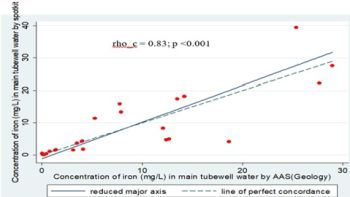Validating a portable device for groundwater iron measurement in Bangladesh
Abstract
The mineral iron is essential for health at an optimum level. In Bangladesh iron is obtained from the drinking source groundwater, attributing largely to the good iron status in population. This groundwater iron poses two scenarios—predominantly high in many areas and predominantly low in other areas. Despite good iron status, burden of anemia in population is high. To control anemia, iron supplementation programs are operational against the backdrop of high iron status. This often leads to iron-associated side effects, plausibly due to excess iron, especially among the individuals exposed to high amount of iron from the drinking water. This geological phenomenon warrants the supplementation program to deliver different doses depending on the groundwater iron level. To enable that, the country needs an area-representative “mapping” of groundwater iron. However, such a mapping using the gold standard laboratory methods is expensive and logistically intensive. The aim of the study is to validate Handheld Colorimeter (HI721 Checker® HC), a portable device (“spot kit” device) to measure iron concentration in the drinking groundwater. The study was carried out in the rural Belkuchi upazila of the Sirajganj district in the Rajshahi division. In the study 25 tubewells were selected and categorized into five groups. Among them, four were categorized based on their iron concentration, low iron conc. (0-<1 mg/L), medium iron conc. (1-2 mg/L), high iron conc. (2-10 mg/L), very high iron conc. (>10 mg/L). One additional group was included for tubewell water that was used after filtering. The study compared the iron estimates measured in groundwater samples of the selected tube wells by the spot kit device and the same samples measured by atomic absorption spectrophotometry (AAS). There was a high agreement between the estimates by the spot kit and AAS (Kappa coefficient= 0.72, p <0.001; Lin’s concordance = 0.829, p < 0.001). Pitman's test of difference in variance exhibited that the two methods produced equally precise results (r=0.227, p=0.275). The study concluded that the Handheld Colorimeter (HI721 Checker® HC) was valid to measure the iron concentration of groundwater under field conditions. This device can facilitate testing processes, particularly in remote or resource-constrained areas where sophisticated testing methods (i.e: AAS) are unavailable and thus may help the re-design of the anemia control program in settings like Bangladesh with high and variable level of iron in the drinking groundwater.

Authors retain all copyrights. In making a submission to World Nutrition, they are certifying that all material is theirs except quotations, as indicated, and that they have obtained permission for any photos, tables, or graphics taken from other publications or websites.




